Hyponatremia is prevalent in hospitalized heart failure patients1,2
24% of hospitalized patients with heart failure (n=103) presented with hyponatremia (serum sodium level ≤134 mEq/L) in an analysis of a muticenter, randomized, controlled study of patients (N=433) hospitalized for decompensated heart failure.1,2
Hypervolemic hyponatremia in patients with heart failure is a marker of excess vasopressin secretion3
Patients with heart failure are at risk for hypervolemic hyponatremia as a result of excess sodium and water retention, promoted by increased vasopressin levels and compromised glomerular filtration.3,4
Clinical profile of patients with hyponatremia in heart failure
Hyponatremia and heart failure have several overlapping symptoms.
Guideline recommendations
ACCF/AHA 2013 Guideline states V2-receptor antagonists may be considered in the short term to improve serum sodium concentration in hospitalized HF patients with persistent severe hypervolemic hyponatremia who are at risk for or are having active cognitive symptoms despite water restriction and guideline-directed medical therapy.12
It has not been established that raising serum sodium with SAMSCA® (tolvaptan) provides a symptomatic benefit to patients.

SAMSCA offers once-daily oral dosing with the flexibility to titrate



